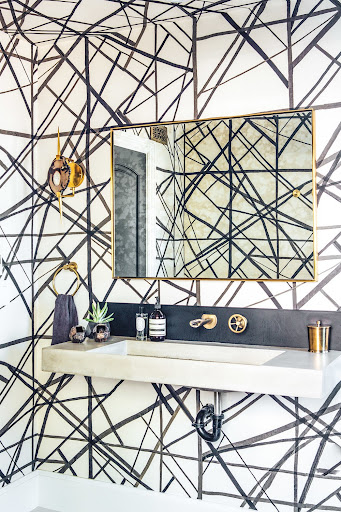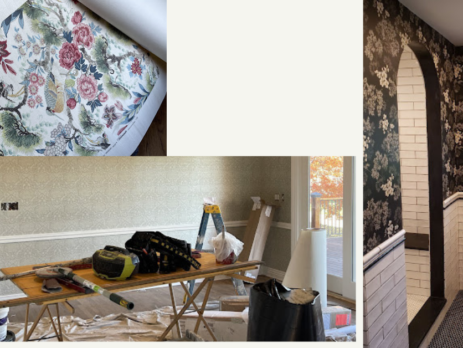
If you’re like us, you likely have vivid memories of spending long weekends removing decades-old wallpaper off the walls of your childhood home. So it’s only normal to have a bittersweet reaction towards wallpaper’s return to fame in recent years. Luckily, modern technology has reinvented wallpaper and brought it into the 21st century, with high-quality material, easier application, and limitless designs.
With developments in digital printing, a new generation of wallpaper fanatics has been blessed with the next generation of artists and designers. Many of these newer trends include large-scale murals and unexpected patterns. Updated printing methods have made wallpaper completely versatile, allowing nearly any design or artwork to be printed onto the adhesive paper.
All of these new developments for the quality and material of wallpaper offer endless opportunities for how you can transform a room. If you’re ready to think outside the box, you can try a thicker, higher-quality wall fabric, such as the ones Porter Teleo offers. Their assortment of hand-painted wall coverings and high-quality fabrics have been credited endlessly for adding warmth and sophistication to a home.
Where it all began


The first form of wallpaper can be traced back as far as 200 B.C. when the Chinese first invented paper and began gluing rice paper to the walls of their home. It wasn’t until the 1960’s and 1970’s that modern wallpaper reached its peak international fame as an inexpensive DIY home improvement project that transformed bland walls with its endless design options. In just a few short decades, the fame began to fade and mid-century Modernism pushed it out of the limelight with the popularity of white walls.
Originally crafted from bamboo fibers, linen, and hemp, wallpaper was used to decorate cupboards and smaller rooms in merchants’ homes, rather than exemplify the extraordinary houses of the aristocracy. Decades later, wallcoverings embodying imagery taken from tapestries that were hung within the homes of the wealthy became popular among the middle class as an inexpensive design option that mimicked signs of wealth and status.
Trending in a big way
Wallpaper is trending in a big way. Whether it’s large-scale patterns such as stylized florals, textured materials such as grasscloths and foils, or handpainted paper, there are limitless options. Unlike the repetitive, small print patterns from wallpaper’s previous rise to fame, creators of the new and improved wallpaper offer everything from rich pigmented fabrics to vivid handmade Japanese paper. The process to create this includes hand-painting designs on the highest-quality Japanese rice paper using richly pigmented artists’ inks, which typically takes between 4 – 6 weeks, but offers a unique and stunning wallcovering.

While wallpaper certainly isn’t a permanent fixture, installing it in your space is still a huge undertaking. This is why we suggest hiring a seasoned professional for the laborious installation. Even if you’re a big DIY-er, this is one home project that you’ll want to keep off your “honey-do” list and leave to a professional. There are a lot of steps to the wallpaper install process that most people don’t know about or don’t think are important, such as, prepping the room, prepping the walls, measuring and cutting the paper, and perfectly aligning the seams.
To fully enjoy all of the benefits that wallpaper can bring to a space, you want to ensure a seamless, clean install that won’t leave damage when removed. Skilled professionals offer a nearly perfect install in significantly less time than a self install. So, save your money and instead of buying the DIY tools and slapping it on yourself, do some research and find a seasoned professional with credible reviews. You can thank us later.
Why wallpaper is for virtually any space
Beyond the visual upgrades of modern wallpaper, the application has been improved upon as well. Made of non-woven materials that are much easier to apply, more sustainable for the environment, and significantly easier to remove without damage to your walls.
Above and beyond traditional application

New temporary wallpaper options even make it possible for renters to renovate their space without worrying about losing their deposit or having the large undertaking of removal when they move out. Gone are the days of scraping away at outdated wallpaper designs with sticky glue fingers while trying not to knick the walls in the process.
The placement of wallpaper has changed too, going beyond the traditional floor-to-ceiling application method. The improved materials of modern wallpaper allow for it to be applied to most surfaces regardless. One trend that we’re loving is the placement of wallpaper on the ceiling. Carrying your wallpaper application up the walls and onto the ceiling can add dimension to a room. Mix it up, try white walls and colorful paper on the ceiling, or colorful paper with a bold wall color to add richness to your space. If your home has a smaller area that seems dull, try adding a small print design to a pantry or closet, or even an entryway or hallway. By utilizing a variety of designs and placement methods, you’ll be able to create a dynamic space that’s rich and inviting.
Make the most of your space with wallpaper
Whether it’s the traditional floor-to-ceiling placement, half wall, or even ceiling-only application, wallpaper has the power to add depth, dimension, and flair to any room in your home. From solid colors, eclectic prints, and textured fabrics, there’s no doubt you’ll be able to find a wallpaper that tickles your fancy. We suggest experimenting with patterns, textures, and application placements to diversify your home’s aesthetic.
About Tran + Thomas
Built on the foundation of a 30-year, family-owned Interior Design business, Jill Tran and Carmen Thomas opened Tran + Thomas Design Studio in 2011 bringing a combined 36 years of experience to their projects. They work on both residential and commercial projects across several styles. Interested in their services? Call (913) 268-9595 or schedule a consultation below.
